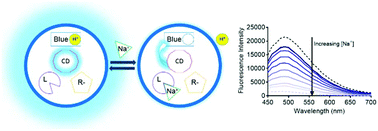Our official English website, www.x-mol.net, welcomes your
feedback! (Note: you will need to create a separate account there.)
Ionophore-based optical nanosensors incorporating hydrophobic carbon dots and a pH-sensitive quencher dye for sodium detection†
Analyst ( IF 3.6 ) Pub Date : 2017-12-04 00:00:00 , DOI: 10.1039/c7an01382e A. A. Galyean 1, 2, 3, 4 , M. R. Behr 1, 2, 3, 4 , K. J. Cash 1, 2, 3, 4
Analyst ( IF 3.6 ) Pub Date : 2017-12-04 00:00:00 , DOI: 10.1039/c7an01382e A. A. Galyean 1, 2, 3, 4 , M. R. Behr 1, 2, 3, 4 , K. J. Cash 1, 2, 3, 4
Affiliation

|
Nanosensors present a biological monitoring method that is biocompatible, reversible, and nano-scale, and they offer many advantages over traditional organic indicators. Typical ionophore-based nanosensors incorporate nile-blue derivative pH indicators but suffer from photobleaching while quantum dot alternatives pose a potential toxicity risk. In order to address this challenge, sodium selective nanosensors containing carbon dots and a pH-sensitive quencher molecule were developed based on an ion-exchange theory and a decoupled recognition element from the pH indicator. Carbon dots were synthesized and integrated into nanosensors containing a pH-indicator, an analyte-binding ligand (ionophore), and a charge-balancing additive. These nanosensors are ion-selective against potassium (selectivity coefficient of 0.4) and lithium (selectivity coefficient of 0.9). Reversible nanosensor response to sodium is also demonstrated. The carbon dot nanosensors are resistant to changes in optical properties for at least 12 h and display stable selectivity to physiologically-relevant sodium (alpha = 0.5 of 200 mM NaCl) for a minimum of 6 days.
中文翻译:

基于离子载体的光学纳米传感器,结合了疏水性碳点和pH敏感的猝灭染料,用于钠离子检测†
纳米传感器提出了一种生物相容性,可逆性和纳米级的生物监测方法,与传统的有机指示剂相比,它们具有许多优势。典型的基于离子载体的纳米传感器结合了尼罗蓝衍生物的pH指示剂,但会遭受光漂白,而量子点替代品则具有潜在的毒性风险。为了解决这一挑战,基于离子交换理论和从pH指示剂分离的识别元件,开发了含有碳点和pH敏感的淬灭剂分子的钠选择性纳米传感器。合成碳点并将其集成到包含pH指示剂,分析物结合配体(离子载体)和电荷平衡添加剂的纳米传感器中。这些纳米传感器对钾离子选择性(选择性系数为0。4)和锂(选择性系数为0.9)。还证明了可逆的纳米传感器对钠的反应。碳点纳米传感器可抵抗至少12小时的光学性能变化,并显示至少6天对生理相关的钠(200 mM NaCl的α= 0.5)稳定的选择性。
更新日期:2017-12-04
中文翻译:

基于离子载体的光学纳米传感器,结合了疏水性碳点和pH敏感的猝灭染料,用于钠离子检测†
纳米传感器提出了一种生物相容性,可逆性和纳米级的生物监测方法,与传统的有机指示剂相比,它们具有许多优势。典型的基于离子载体的纳米传感器结合了尼罗蓝衍生物的pH指示剂,但会遭受光漂白,而量子点替代品则具有潜在的毒性风险。为了解决这一挑战,基于离子交换理论和从pH指示剂分离的识别元件,开发了含有碳点和pH敏感的淬灭剂分子的钠选择性纳米传感器。合成碳点并将其集成到包含pH指示剂,分析物结合配体(离子载体)和电荷平衡添加剂的纳米传感器中。这些纳米传感器对钾离子选择性(选择性系数为0。4)和锂(选择性系数为0.9)。还证明了可逆的纳米传感器对钠的反应。碳点纳米传感器可抵抗至少12小时的光学性能变化,并显示至少6天对生理相关的钠(200 mM NaCl的α= 0.5)稳定的选择性。









































 京公网安备 11010802027423号
京公网安备 11010802027423号